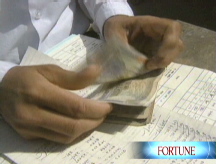Problem banks rise to 13-year high
The FDIC reports that the number of troubled banks grew to 171 in the third quarter, most since 1995. Bank profits have second-worst quarter since 1990.
NEW YORK (CNNMoney.com) -- The government's watch list of problem banks grew staggeringly in the third quarter, according to a government report on the embattled financial sector released Tuesday.
The Federal Deposit Insurance Corp. reported that the number of firms on its so-called problem bank list grew to 171 during the third quarter - the highest since 1995 when there were 193 banks on the list. There were 117 banks on the list in the second quarter.
"We've had profound problems in our financial markets that are taking a rising toll on the real economy," said Sheila Bair, FDIC chairman, at a press conference. "Today's report reflects these challenges."
Though the FDIC does not reveal the names of the banks on the list, it said the total assets of these institutions rose to $115.6 billion in the third quarter from $78.3 billion in the previous three months, the first time since 1994 in which the assets of problem banks exceeded $100 billion.
Since home prices began to decline late last year, banks have faced strong headwinds as the value of their mortgage-backed securities declined sharply in value. Those assets became "toxic" holdings on their balance sheets, resulting in a lending freeze, soaring borrowing costs and large writedowns.
"Banks got caught in a vicious cycle mainly of their own developing," said Matt McCormick, analyst at Bahl & Gaynor Investment Counsel. "The lowest common denominator turned out not to be their best client; for all their brilliance, they flunked Economics 101."
Still, just 2% of FDIC-regulated banks are now on its watch list, compared to about 10% in the late 1980s and early 1990s during the savings and loan crisis. The government identifies problem banks as institutions on the brink of failure, facing severe financing difficulties and management issues. But few banks typically reach that point - just 13% of banks on the FDIC's problem list have failed on average.
"Most banks remain well-capitalized, profitable and sound," said Bair. "We believe the overall majority of them will not fail."
Three more banks failed on Friday, bringing the total to 22 failed banks so far this year - compared to just three in 2007. Nine banks failed in the third-quarter alone, including the collapse of savings and loan Washington Mutual, the largest bank failure in history.
This was the highest number of failures in a quarter since the third quarter of 1993 but pales in comparison to the more than 1,000 banks that failed during the savings and loan crisis. Still, the failures in the third quarter forced the FDIC to draw down $10.6 billion from its deposit insurance fund.
That number could rise substantially if there are more bank failures. Beginning in October, the FDIC began insuring interest-bearing accounts up to $250,000 (the previous limit was $100,000) and has issued unlimited guarantees on non-interest-bearing accounts and newly issued unsecured bank debt as part of the government's financial rescue initiatives.
Toxic assets continued to weigh on the industry's profits, which fell 90% to $1.7 billion in the quarter from $28.7 billion a year ago. That was the second-lowest quarterly net income for banks since 1990, the FDIC said. About one in five banks reported a net loss in the quarter, compared just to one in eight during the same period last year.
Much of that decline was due to loan-loss provisions, which totaled $50.5 billion in the quarter after banks set aside $50.2 billion in the previous quarter. That's more than three-times the $16.8 billion in loan-loss provisions from the fourth quarter of 2007.
"Loan performance problems are spreading to a much wider range of lenders and category of loans," said Bair. "This trend is linked to a weaker economy and uncertainty in the financial markets."
Also contributing to damaged profits were loan losses, which rose for the seventh consecutive quarter. Net charge offs, or loans banks don't think are collectable, rose to $27.9 billion in the quarter, up from $17 billion during the same period a year ago, and its highest level since 1991.
In a sign that credit remained tight, banks borrowed $162.5 billion from the Federal Reserve's emergency lending window, up 4.8% from the same period a year ago. In its so-called "discount window," the Fed offers overnight funding for commercial banks at a rate slightly higher than its targeted funds rate.
Bair said smaller community banks with assets of less than $1 billion are also beginning to feel the stress of the weak economy, even though they remain better capitalized than the industry average.
As a result, Bair said it is essential that those banks take part in the Treasury Department's capital purchase program and the FDIC's new temporary liquidity program to stay afloat.
But there were some bright spots in the report. One of the government's early liquidity programs, which provided support to money market mutual funds by funding banks' purchases of asset-backed corporate debt led to a 2.1% boost of banks assets in the quarter. And banks' net interest income rose 4.9% to $4.4 billion as borrowing costs rose.
"It's important to emphasize that banks in large part still made money in the third quarter, which was a very difficult one," said Gary Townsend, president of the Chevy Chase, Md.-based Hill-Townsend Capital. "The fourth quarter is likely to be worse, but last quarter they paid forward a lot of loan losses."
Bair said the poor credit conditions will persist for some time, as it will take a while for sentiment to improve and for the numerous government liquidity programs to take effect.
She added she will continue to work with President-elect Obama's administration beginning Jan. 20 to help stabilize the financial sector. ![]()


